SLM Jason Nolan Helps Turn Pristine Alberta
Into a Post-Apocalyptic Landscape in The Last of Us
by Shaun O’Banion
A Video Game Inspires a Series
In 2013, Sony had a massive hit game on their hands with The Last of Us. Created by Neil Druckmann, the game sold more than 1.3 million units in its first week of release alone and by 2018, had sold 17 million.
The game is set in a post-apocalyptic world where Joel, a hardened survivor and smuggler, is tasked with taking 14-year-old Ellie on a treacherous quest across a ravaged United States to help find a cure for a devastating fungus.

Photo courtesy of HBO/Liane Hentscher
In a gaming chatroom, when someone asked why people believe the game is the best-ever made, gamer Jayant Lahoti replied, “Because it is. That’s it. The Last of Us is the most heart-wrenching, soul-crushing, unapologetic piece of fine art ever. It’s not a game, it’s an experience. The whole game just rips your heart out and stuffs it down your throat. And I dare you to play this game without crying.”
Though that may sound hyperbolic, co-showrunner/writer-director Craig Mazin agrees. In an interview with online journalist Jonatan Blomberg (conducted prior to the May 2 WGA Strike) he said, “I had never played a game like it, and I don’t think I had ever felt that much about a game—throughout it, not just at the end—and I was almost sad because I thought, ‘I’ll never get a chance to bring something like this to the screen.’”

Neil Druckmann stands on the real-life version of freeway. Photo by Jason Nolan/LMGI
Mazin, known primarily for comedies like The Hangover Part II, had recently surprised the industry with his Emmy-winning limited series Chernobyl for HBO and, following that success, he was offered a meeting with Sony execs to see if he might be interested in adapting any of their game properties.
At the meeting, Mazin was handed a list of titles to choose from, but when he flipped through the pages searching for The Last of Us, it surprisingly wasn’t there.
The execs explained that Druckmann was trying to make it into a movie. “Immediately, I was like, ‘mm-mm. It’s not a movie. It’s gotta be a show,’” says Mazin. The Sony execs set a meeting for Mazin to pitch his take for adapting the game as a series. Druckmann loved the pitch, and, with the full support of HBO, they were off.
SLM Jason Nolan/LMGI
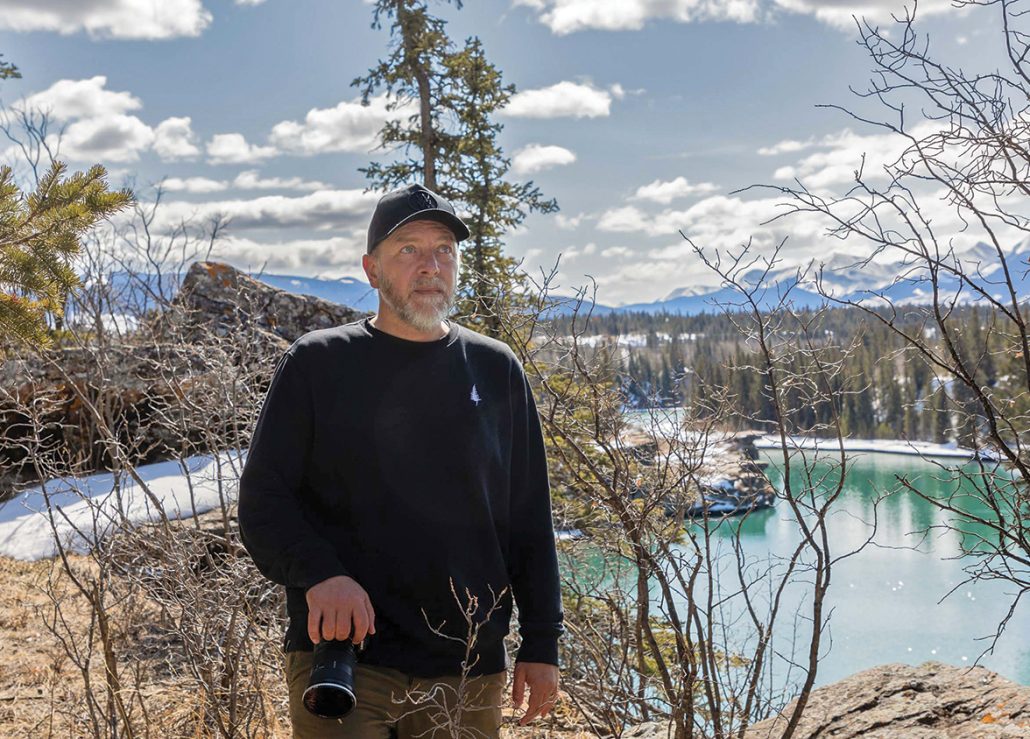
Jason Nolan/LMGI
Courtesy of Jason Nolan/LMGI
SLM Jason Nolan/LMGI was prepping Prey, the latest entry in the Predator film series for Fox, when he got a call from Luke Antosz who had worked for him as a KALM in the past.
“He asked if I’d ever played The Last of Us,” Nolan recalls. “And, of course, I’d heard of it, but I didn’t know much about it.”
Antosz was a huge fan of the game and was going on about what an amazing show it could be. “He told me he’d been tipped off by our film commission that some people from HBO were headed up to Canada to scout,” Nolan says, “and asked if I’d be willing to help prepare some image pulls for them.”
After reading the pilot, Nolan found himself so intrigued by the storyline that he picked up a couple of books about the art and design of the game to have a better sense of what HBO might need.
“Location and setting were so central to the journey of these characters,” says Nolan. “The locations set the mood and created a landscape for the harrowing experiences the characters navigate through in a world that had been transformed.”
Nolan grew up in Ottawa, Ontario, Canada, and became fascinated by photography at a young age, using the family camera to take pictures whenever possible. He also discovered the magic of film and television and realized that there was one element of the process he always found himself more curious about than any other:
“I wondered how they found all the places they’d shoot in,” Nolan laughs. “Like, I’d be watching E.T., and Elliott would go from his house to the redwood forest over the mountain and I’d be like, ‘is the forest really behind that mountain? How did they find that?’”
“Location and setting were so central to the journey of these characters. The locations set the mood and created a landscape for the harrowing experiences the characters navigate through in a world that had been transformed.”
-SLM Jason Nolan/LMGI
By his teens, he knew he wanted a career in film so, at age 19, he decided to give it a shot. Despite having no connections in the business, he drove to Vancouver and hit the pavement. Miraculously, he booked a job as a production assistant not long after his arrival.
One day, a location manager asked if he had a camera. In that moment, all those years spent developing his photography skills were about to fuse with his dream career. He soon found himself out on the road photographing various potential locations for a project.
“To me, that was crazy,” he recalls. “I mean, it never occurred to me, that that was how you’d find locations … just by going off on your own with a camera, taking pictures and talking to people.
He moved his way up in the location department rapidly and was nearly a decade into his career when Antosz drew him into helping out on The Last of Us. Despite his interest, Nolan assumed that helping pull images was the end of it since Prey and The Last of Us seemed to overlap.
Boots on the Ground
Producer Rose Lam would serve as the “boots-on-the-ground” representative for co-showrunners Mazin and Druckmann. She narrowed down the photos Nolan had helped put together and headed up to Canada for nearly a week of scouting in both Manitoba and Alberta with Antosz, an executive from HBO and two members of the local film commission.
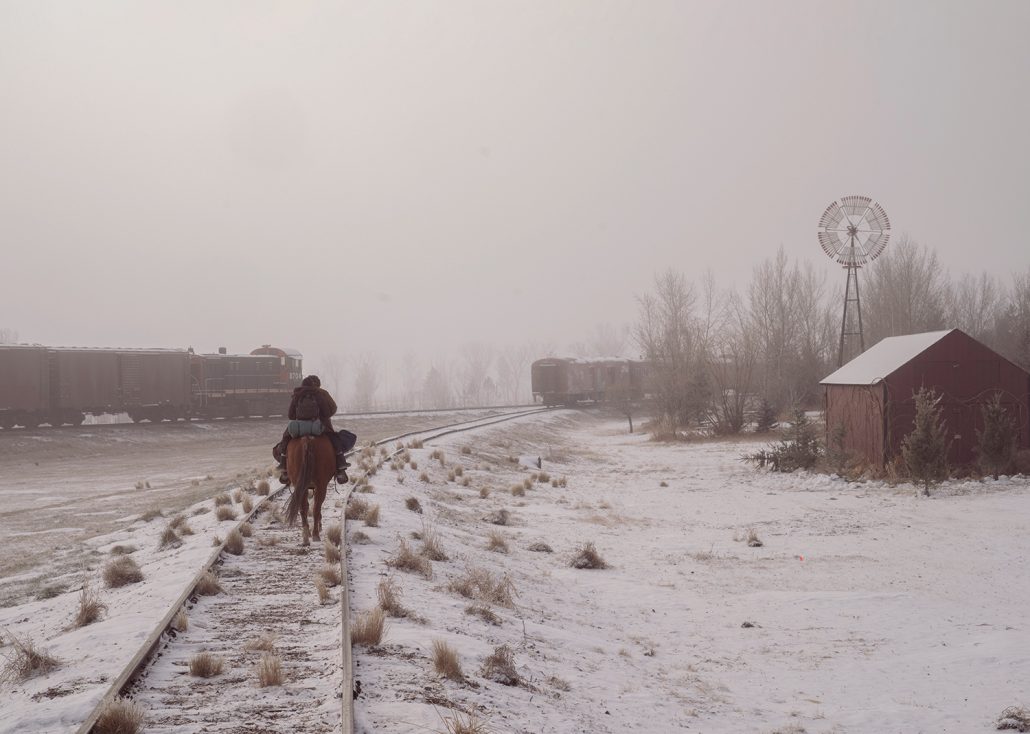
Photo courtesy of HBO/Liane Hentscher
When Lam returned to Los Angeles, she presented her findings to Mazin, who would be directing the pilot, Druckmann, who was set to direct episode two (his first time helming an episode of television) and other HBO execs.
The team settled on Alberta due to the variety of different terrain and architecture, as well as the fact that Manitoba gets much harsher winters, and the shoot was expected to take as much as a year.
When production designer John Paino joined the production, he was surprised at how clean and well-cared for everything in Alberta appeared to be.
“I’ve worked all over,” he says, “and pretty much everywhere you go, you can find an area that’s a bit … run down. Not there. The Canadians keep things pretty buttoned up. Very clean and neat which, of course, was not what we needed.”
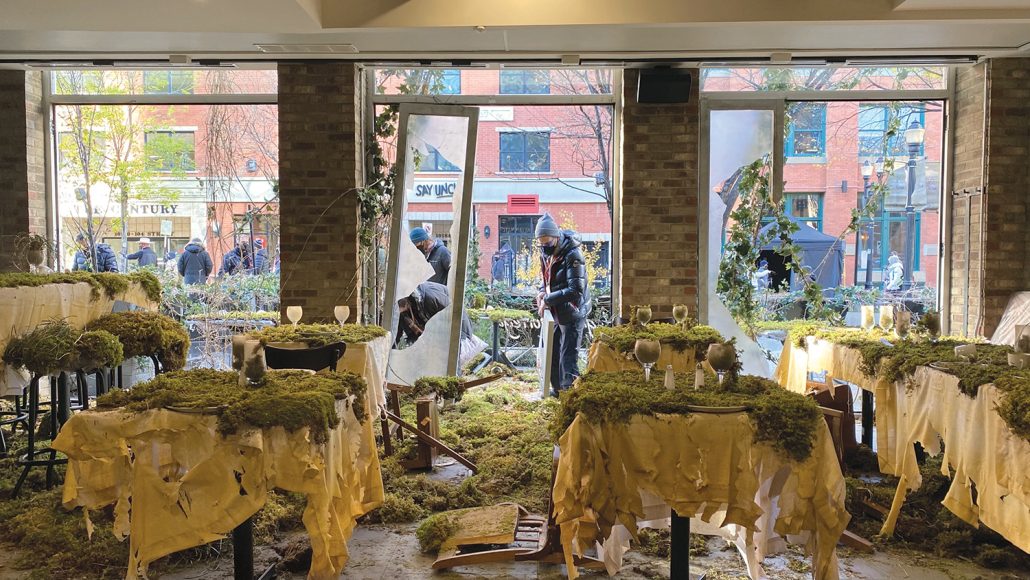
Photo courtesy of HBO/Liane Hentscher
What was needed was a world ravished by a hideous fungal infection that attacks the body from the inside, growing like a mushroom and sprouting outward. With roots spreading underground, the fungus also bursts above ground overtaking physical structures and interior surfaces. Humans are turned into deformed-crazed-zombies and, as the fungus takes hold, cities are destroyed as the uninfected attempt to eradicate the zombie hordes with bombs.
In other words, it was going to require a lot of work to make the area look, well, bad and to be able to get it all done, they were going to need an absolutely top-notch Location Department.
Impressed with the images Jason had put together for the scout months earlier, they asked him to join the team. As Prey was nearing completion, he was able to accept.
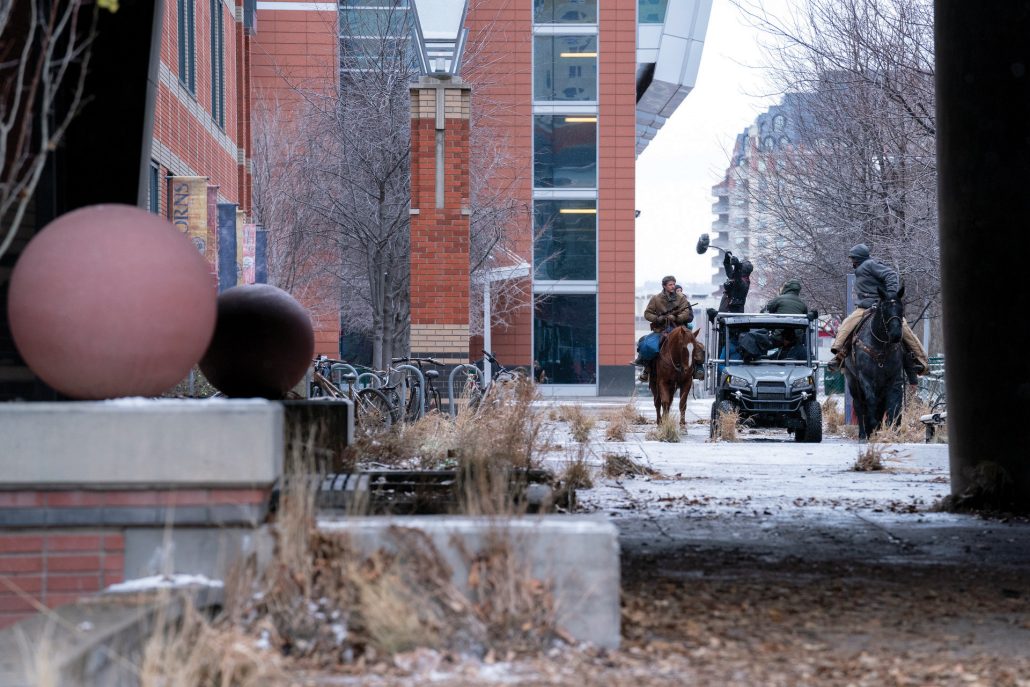
Photo courtesy of HBO/Liane Hentscher
The mandate from the start was that The Last of Us would not be a show with actors walking past green screens or LED walls. This show would be about placing the actors into real locations that would then be extensively dressed. “In the story,” Paino says, “Joel meets Ellie (played by Pedro Pascal and Bella Ramsey in the series, respectively) after the world has shut down, and they make their way across the U.S. The audience needed to believe, first of all, that Joel and Ellie were moving through those different states … but even more important was to give a sense that nature had completely taken over. That’s what gives the show its gravitas and it was very important to Neil, Craig and the rest of the team.”
In vast areas of Canada, from Alberta to Calgary, Edmonton and surrounding suburbs, Jason and his team were called upon to find versions of Boston, Kansas City, Wyoming, Texas and Utah so that Paino and the art department could then turn them into overgrown wastelands.
Diving In
Nolan started building his team immediately: He hired KALM Antosz for the full run, along with a few others he’d grown close with over the years, including scout/LM Mohammad “Mo” Qazzaz/LMGI.
“The goal in the beginning,” says Mo, “was to build up a library of possible locations as quickly as possible.”
Official prep began in January of 2021 with the shoot set for July. Paino set about working to create the look of the show, along with DP Ksenia Sereda. They connected with Nolan immediately and were impressed by the team he’d assembled.
“I thought they did a really good job finding places—especially given our schedule—that could work for what we needed or that could at least create a foundation we could build on,” says Paino.
Sereda echoes that sentiment. “Jason knew the area, the people and he really understood how to support Neil and Craig’s vision for the show.”
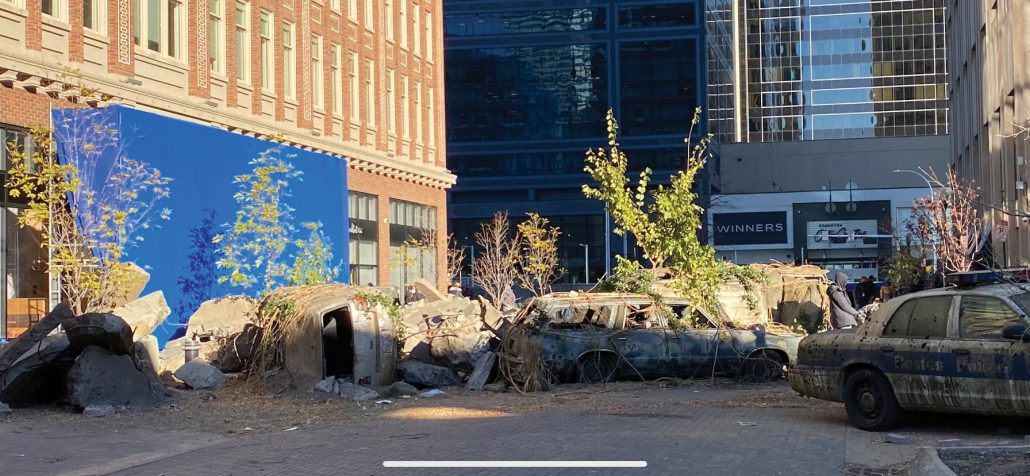
Photo by Jason Nolan/LMGI
Paino’s art department began churning out concept art and, of course, they had the vision from the game which Jason had seen in those art books he’d picked up early on in the process.
They also found a valuable resource in YouTube. “Gamers spend hours playing the game and then post it all on YouTube,” Mo explains, “so watching those videos would give you a good idea of the feel of things and, anytime a new set or location came about, the team would start by looking at the location from the game on YouTube and then we’d try to match it in real life.”
“Everywhere we looked, we always kept the game in mind, but then there are production realities that creep in,” adds Lam. “With a game, you can do whatever you want, but when you’re shooting live action in the real world, although we were mucking up the real world, there were other parameters that we really needed to consider.”
Visual Scope and Large Scale
“As soon as we moved into active prep, the scale of the show hit me,” Mo laughs. “Requests started pouring in from all over and my role transitioned into planning, logistics, deploying and supervising our department’s human resources, negotiating contracts and most importantly, maintaining efficient communication with other departments.”
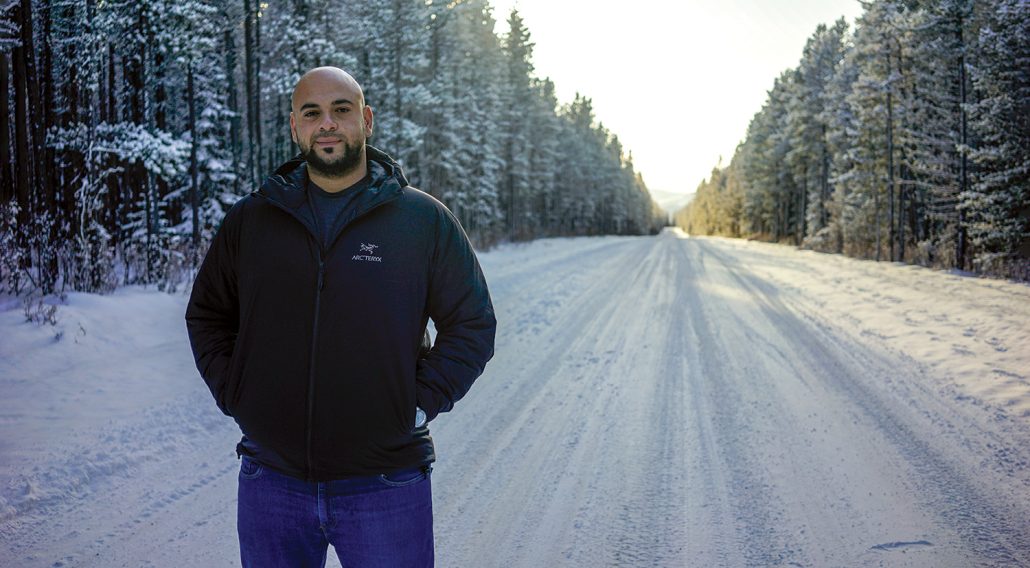
LM Mohammad “Mo” Qazzaz/LMGI
Overall, the roles in the department were fairly fluid. If there was an area where support was needed, the team would jump in and assist and, by the end of the show, the department had grown to 22 full-time LMs, ALMs and an additional 18 to 20 location PAs on set each day.
“There were no recurring locations on the show, so we were always prepping, shooting and wrapping at the same time,” says Nolan, “and that overlap was continuous for nearly a year. Often we had about 80 people in our department and frequently over 100.”
A Bravura Opening Sequence
At the start of the series, we’re in 2003, years before Joel will meet Ellie, and we get to experience the beginning of the infection as the fungus takes hold of his neighbors and turns them into crazed zombies. In a pulse-pounding five-minute-plus sequence, Joel, his daughter and brother jump into their truck and make a high-speed escape from their once quiet cul-de-sac in “Austin, Texas.”
“We scoured just about every town, neighborhood and street in the province to find the right home and the right street for that,” Jason says. In fact, the team looked at more than 300 houses and, when they finally found the house and street they would end up using in an area called High River, they all knew it was the one.
There was another factor at play that is important to mention here: the real-life pandemic.
“People didn’t really want to deal with a film crew and COVID,” Paino says, “and that’s if they were even home in the first place.”
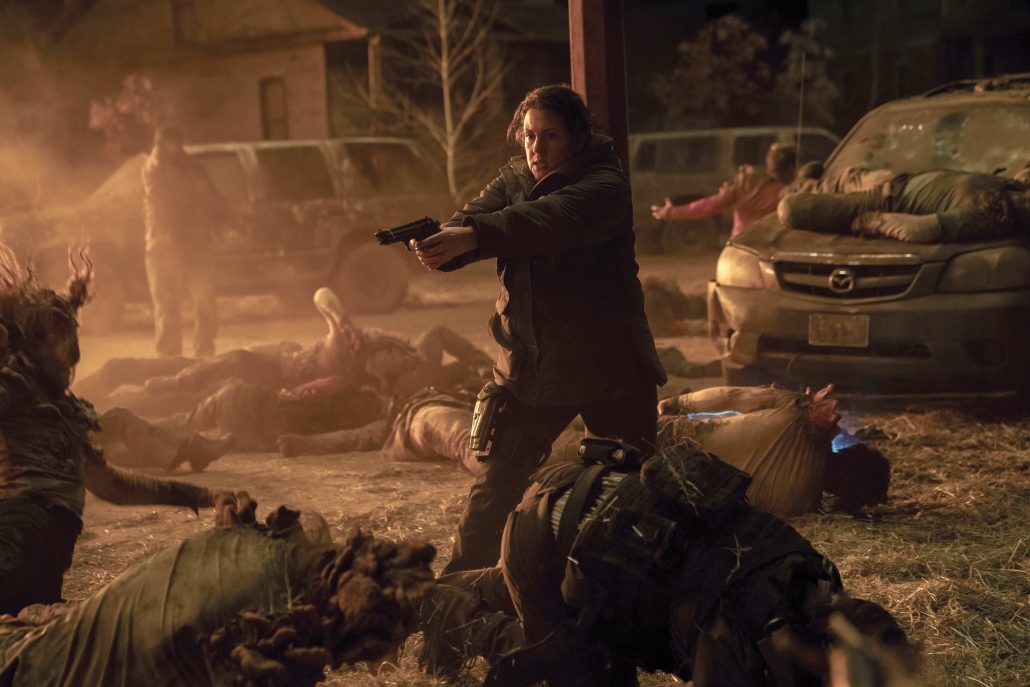 A lot of residents had fled towns and cities, so there were places the team were interested in where the residents just never turned up. Jason would have someone from his team sitting on a kind of stakeout hoping the owners would eventually come home—but they often didn’t.
A lot of residents had fled towns and cities, so there were places the team were interested in where the residents just never turned up. Jason would have someone from his team sitting on a kind of stakeout hoping the owners would eventually come home—but they often didn’t.
Finding the hero house on the cul-de-sac in High River was only the beginning…
For the sequence, which shot over five or six nights, the production would require no less than nine separate locations stitched together to pull off.
From High River, the scene then moves to Fort Macleod in Southern Alberta where they drive onto main street, encountering hundreds of people—many of them infected—as they pour out of movie theaters, bars and hotels. It’s absolute chaos brilliantly organized and realized by the creative team.
The bright side to the street location was that behind one of the rows of buildings was a parking lot running almost the full length of the street, so the crew was able to base there. They also placed massive lighting cranes in the lot.
“…one day you look at the concept art and then you’re standing on location holding up that image and it matches perfectly, or the actors walk onto set and you hear them go, ‘Wow, man we’re in the game,’ that’s a really special feeling.”
-SLM Jason Nolan/LMGI
“We basically bought up every square inch of available space in the town that was on the street or nearby,” Jason says, “including a hockey arena two blocks away where we were able to set up a secondary base to process the large number of stunt performers and background artists.”
As with every single location on the show, everything on camera for the sequence was dressed by the art department, which often changed out facades completely so that stunt people could come crashing through windows and send glass flying.
“It was a lot of work,” Jason laughs. “Nearly 150 location agreements for the main street chunk of the scene alone.”
Once the narrative moves into present day, every set had to be aged to show the ravages of time. Decaying streets with cracks and water blisters. Crumbling buildings and infrastructure. Nature reclaiming cities. If a scene involved a road or highway, they would bring in cars rather than relying on CG.
“Our greens department had to bring in clumps of grass and vines to lay in, along with debris and rocks everywhere we went,” says Paino. “And with the cars, it’s not like you just bring them in and drop them there. First, they have to be circa 2003 or earlier. Then they have to be aged as if they’d been sitting there for decades and rusted out. The tires all had to be deflated. It was a big, big job.”
Jackson
In stark contrast to almost every other location in the series, in episode six, Joel and Ellie arrive in “Jackson, Wyoming,” to discover a town that is miraculously fully functioning. A sanctuary.

The gates of Jackson.
Photo by Jason Nolan/LMGI
Inside the 30-foot-tall log wall that has been erected to protect the survivors inside, life is seemingly normal. The town includes all the accoutrements of a normal town pre-fungus, but many are things Ellie has never seen before. Electricity, for example. There’s even a movie theater and a fully decorated Christmas tree placed in the town square.
The location was found in Canmore, a town first incorporated in 1884, located roughly 50 miles west of Calgary. For Paino, the Canmore Street was the most impressive find.
“Jackson still has this frontier feel and Canmore fit that element beautifully,” Paino says. “But more than that, I had been to Jackson and when you stand on the main street there, you can see the Rockies. In Canmore, the Canadian Rockies are right at the end of the street which meant that it was real and felt real. No VFX required.”
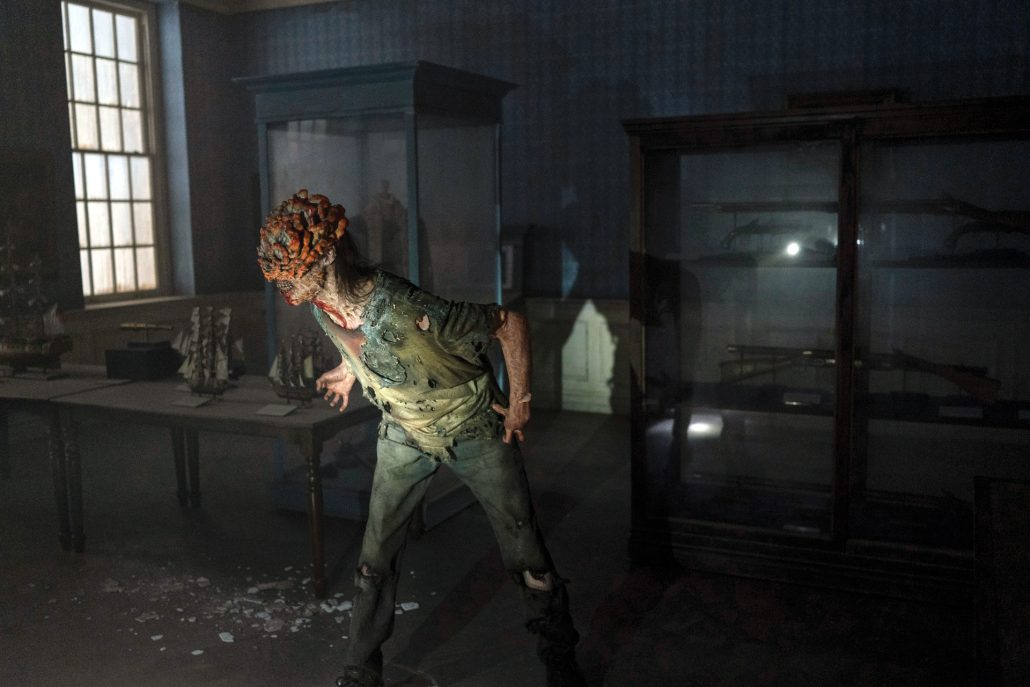
The Last Of Us
“We knew almost a year out that we wanted to film a large part of this episode in Canmore, so I met with the town officials the spring before,” says Nolan. Over the course of the year, more and more meetings were held as getting final approvals would require the full support of the mayor and city council.
In the end, they received unanimous approval.
“They had to dress the entire street and build awnings and some facades to incorporate some real Jackson locations,” says Nolan. Then there was that wall.
“The massive gate needed to be able to open and close, not just for picture, but to allow residents and tourists through before the shoot,” Nolan says. “It also meant we needed traffic control 24 hours a day for more than a month as we reduced the road down to one lane.”
Canmore, it turns out, is a very busy town. Just 15 minutes from Banff, it has a bustling local community and a high influx of tourism in the winter. To add to the complication, they shot the episode leading up to Christmas, so shopping was full-on.
“We kept businesses open while prepping for three weeks,” says Nolan, “and it was hard to manage all the pedestrians. When we were finally ready to shoot, we closed all the streets and bought out all the businesses.”
The filmmakers wanted snow for the scenes but, in the weeks leading up to the shoot, Mother Nature had denied them. Luckily, she had a change of heart and decided to sign her location agreement the night before the shoot.
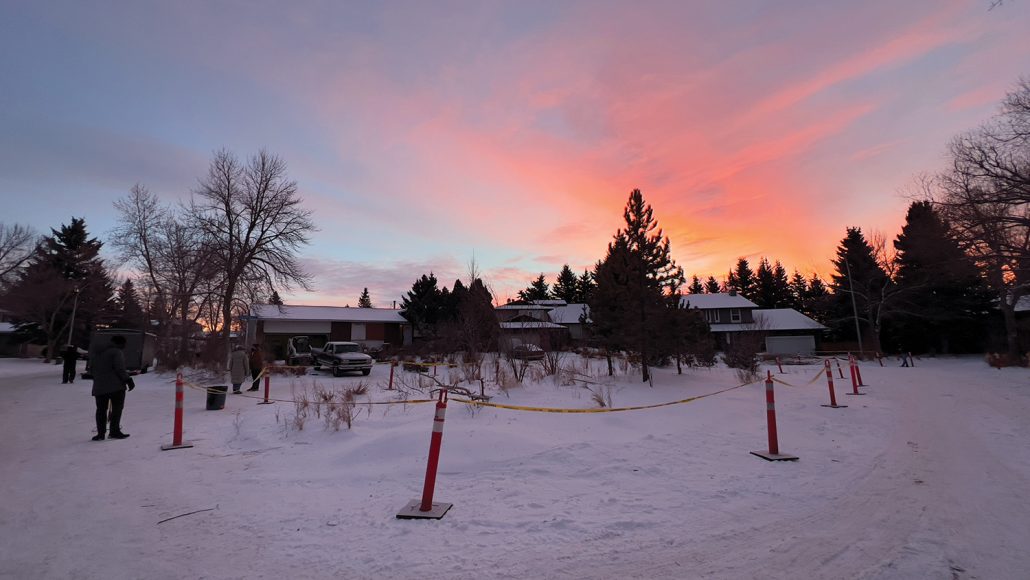
Protecting the set; Photo by Matt Palmer/LMGI
“We ended up with a winter wonderland the morning of and our director was actually upset because the snow was so heavy, you couldn’t see all the mountains at the end of the road,” recalls Nolan, “but the sun burned it off, it turned out great and everyone was happy.”
For the Christmas tree, they brought in the biggest tree they could find that would fit on a semi-trailer and, after the filming, moved it out of the middle of an intersection where it had been placed for picture to a better spot for the residents to enjoy over the holidays.
Photography on the main street took a week. Nearby, they took over several public parking lots where practical horse stables were built for a few scenes.
“We, of course, wanted snow in those scenes but there wasn’t much,” says Nolan, “so the SPFX department trucked a lot in from the surrounding mountains. Another task that took a tremendous amount of coordination.”
Okotoks
Matt Palmer/LMGI (featured previously for a 2022 LMGI Compass article on Hulu’s Under the Banner of Heaven) was brought in when sections of episodes three and four needed to be reshot and Nolan needed an experienced location manager to handle the last two episodes.
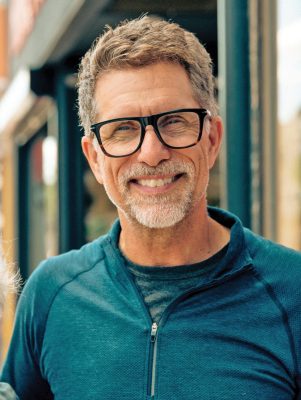
LM Matt Palmer/LMGI
“While they were busy working on their episodes, I set to war prepping the last two,” Palmer says. “It was a tremendous challenge, but it’s a great thing when you have time, resources and support to do your job.”
In episode eight—spoilers ahead—Joel has been seriously injured and, while attempting to find help for him, Ellie encounters a group of survivors who appear to be deeply religious people but are actually harboring a vile and deadly secret.
The episode would require a complete takeover of an entire neighborhood in order to portray the community. They ended up finding it in the town of Okotoks, south of Calgary.
“Prep started at the main house in January,” says Palmer. “The owner of the home had lived there since the early 1970s and we had to basically take it apart so that it looked like no one had lived there for 20 years and it had completely degraded inside.”
As they got closer to filming the art, greens and SPFX teams had to take over the streets, dress snow everywhere and age and degrade yards, backyards and the local park. “We moved 18 families out for 10 days to allow for the final dressing and a week of filming,” says Matt.
When you need weather, you often don’t get it and, unlike what Nolan and the team ended up with in Canmore, Mother Nature didn’t cooperate in Okotoks.
“When we started working, there was a lot of snow which is what the scenes required, but a warm spell melted almost all of it,” Palmer says, “so the SPFX team ended up having to bring in over 300 truckloads of the stuff!”
Looking Back
Altogether, The Last of Us collected more than 1,000 signed agreements and shot at 180 locations over the course of the season, including shutting down the airport tunnel in Calgary, closing the Fourth Avenue Flyover in Calgary for a week, building a town in High River, Alberta, using the Alberta Legislature Building in Edmonton to double as Boston, the Northland Village Mall in Northwest Calgary and building another entire street on an empty lot outside the Calgary Film Centre.
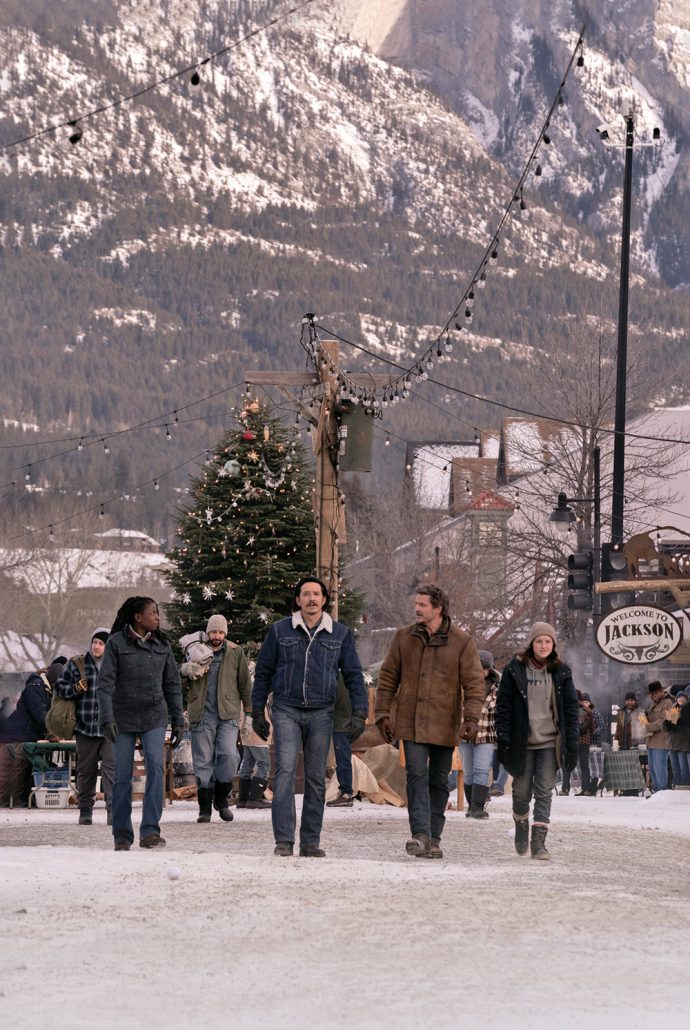 Nolan and his team are currently working on a new Netflix series, but when he looks back on the experience of making The Last of Us, he’s proud of what they were able to accomplish.
Nolan and his team are currently working on a new Netflix series, but when he looks back on the experience of making The Last of Us, he’s proud of what they were able to accomplish.
“It is absolutely the biggest thing I’ve ever done and I can’t even begin to truly describe the level of things that were always going on simultaneously,” he says, “but that’s when you rely on your team … and when you look at the concept art and then suddenly, one day you’re standing on location holding up that image and it matches perfectly, or when the actors walk onto set and you hear them go, ‘wow, man, we’re in the game,’ that’s a really special feeling. I’m grateful to my entire team for making it happen,” he says.
Season 2 of The Last of Us, which has already been greenlit, is expected to move to Vancouver.
The Last of Us
Location Department
SLM Jason Nolan/LMGI
LM/Scout Mohammad Qazzaz/LMGI
LM Matt Palmer/LMGI
LM Dennis Penney/LMGI
Locations Coordinator/KALM
Shauna Nolan/LMGI
KALM Luke Antosz (On set)
KALM Alex McGregor/LMGI
KALM Maeve Orlady
KALM Sarah Ellis
KALM Bill Kerr
KALM Kevin Larsen (On set)
ALM Jennifer Pauley
ALM Gautam Dharan
ALM/Scout Ryan Leedu
ALM Shane Donovan
ALM Ben Owens
Scout AJ Valadka
Scout Shaun Robinson
TLM Conor Samphire
TLM Travis Coulliard
TLM Ismail Okasha
TLM Stellar Nolan
TLM Clayton McGladdery
TLM Rich Bell
TLM Jim Gilfillan



